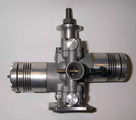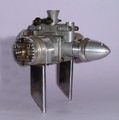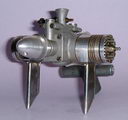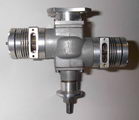DC Tornado Twin
by Adrian Duncan
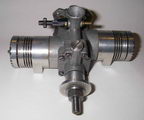 |
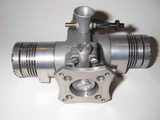 |
|
| Click on images to view larger picture. | ||
The Davies-Charlton company had started in 1947 at a rather obscure location in Barnoldswick, Lancashire, where they made first the DC Wildcat 5.3cc diesel and then the 3.49cc DC 350 diesel and glow models. Their early products appear to have been designed primarily by Hefin Davies.
During the early 1950�s the company diversified and became involved with defence contracts, which took up an increasing amount of Hefin Davies� time. This situation appears to have prompted a change in early 1952, when Davies-Charlton joined forces with Alan Allbon who had been making his own rather more diverse engine line since 1948 at a plant located at 51A Thames Street, Sunbury-on-Thames, Surrey, just to the west of London (not Middlesex as reported by Sparey!). This was very close to the successive haunts of the ED company at Kingston-on-Thames, West Molesey and Surbiton and not actually all that far from the International Model Aircraft (Frog) plant at Merton, just to the east. The model engine industry was a significant employer in this area!
The merger allowed Davies to continue to lead the doubtless-lucrative defence-related work while Allbon assumed primary responsibility for the model engine development and production program. The plant at Sunbury was closed down and production of the Allbon engines by that name was transferred to Davies-Charlton�s Barnoldswick plant in Lancashire along with that of the continuing Davies-Charlton models. However, in late 1954 a move to the Isle of Man was put in hand, presumably for tax and business incentive reasons. Subsequent Davies-Charlton products were manufactured at the relocated and modernised Davies-Charlton factory at Hills Meadow, Douglas, Isle of Man.
The Allbon name was progressively dropped following this move, seemingly disappearing entirely in 1957. Alan Allbon parted company with Davies-Charlton in 1959 and joined forces with a Mr. Saunders to make the excellent little 0.55 cc AS 55 diesel in the early 1960�s before abandoning the model engine field for the optical industry.
Before he left Davies-Charlton, Alan Allbon was no doubt closely involved in the development of that firm�s most ambitious project of all—the simultaneous-firing opposed-twin 4.87 cc glow-plug motor known as the Tornado. This most unusual engine was designed and announced in 1958 and began appearing on the market in 1959. I don�t know whose initiative led to the design and production of this engine, but the result was impressive!
An excellent description of this fine engine is to be found in Peter Chinn�s test which was published in the July 1960 issue of Model Aircraft, and it seems unnecessary to do more here than summarize the highlights. The engine was very slightly under-square with a bore and stroke of 0.570" x 0.582" respectively (14.48mm x 14.78mm) for a combined displacement of 4.867 cc. The weight of the unit, minus the optional exhaust stacks, was 10 ounces exactly (284 gm). A bit heavy for a 5 cc glow engine, but not excessively so considering the design challenges involved.
The Tornado looked like a pretty conventional simultaneous-firing opposed twin with the usual staggered cylinders to accommodate the two-throw crankshaft. However, it did display some quite original thinking. For one thing, the shaft was a one-piece twin-throw unit rather than following the more common pattern of using composite construction. The use of the one-piece twin-throw crankshaft forced the makers to use split conrod big-end bearings exactly like those used in full-sized engines. These were secured with 8BA high-tensile bolts and lock-washers. Sounds a bit dodgy, but in fact this arrangement rarely if ever gave any trouble.
The shaft was necessarily supported at both ends, the finely-finished steel journals running in closely-fitted un-bushed bearings of quite generous length in the end cover casting material. I consider the un-bushed main bearings to be a potential weakness of this design. In an engine of this kind, there is no "give" in the shaft since it is made in one piece and has no "joints" or points of connection. Accordingly, the slightest mis-alignment of the bearings will be reflected in the generation of cyclic bending stresses in the crankpins—the classic fatigue situation. It is critical to avoid such stresses in the crankpins, which can become very substantial if the journals at each end are free to flex out of alignment to any degree. If it had been me, I would probably have used Meehanite bushings for the two bearings in order to permit an even closer initial fit to be achieved by lapping and to preserve that close fit over the working life of the engine. But cost was probably becoming a critical factor even without such refinements, as was weight and it is true that the bearings are of fairly generous length and their fit and alignment as supplied seem to be beyond reproach. Top marks to Davies-Charlton in that regard!
The most unusual feature of the engine was the fact that advantage was taken of both ends of the crankshaft to aid in the induction process. There were conventional shaft rotary valves at each end of the engine, but these were fed through a common longitudinal header passage which was in turn supplied by a single carburettor located centrally on top of the main case. The engine thus had two rotary valves feeding a common crankcase, but only one carburettor and hence only one needle valve. Clever!
The opposed-twin layout naturally forced the use of radial mounting for the unit. The engine came with a pair of exhaust stacks which could be attached to get the exhaust clear of the model in a cowled mounting situation. The stacks were no longer with my example when I acquired it, unfortunately, and neither was the original box. The spinner nut was also long gone. Pity!!
Peter Chinn reported obtaining 0.37 BHP at 14,000 rpm running on low nitro fuel. These are both extremely good figures for a twin, and Chinn commented that the addition of some nitro would probably push output up over the 0.40 BHP mark. The engine was also tested by Ron Warring in the September 1960 issue of Aeromodeller magazine, and a figure of 0.397 BHP was obtained, albeit at the somewhat lower speed of 12,200 rpm. However, this second test confirms the validity of Peter Chinn�s comment regarding the engine�s power potential. Warring must have extracted considerably more torque than Chinn to have achieved this result!
Chinn was most complimentary regarding the starting and general handing qualities of the unit, commenting particularly on the "negligible" vibration of the engine when running. This is of course to be expected from such a design, since the reciprocating components are essentially balanced apart from the small rocking couple arising from the unavoidable staggering of the cylinders.
This freedom from vibration probably accounts for a characteristic which was noted both by Chinn and others, namely that the Tornado had the potential to pick up speed in the air to a greater extent than a conventional motor. This aspect of the engine�s performance came in for specific comment in an interesting article on twin-cylinder model aero engines which appeared in the 1959 Aeromodeller Annual. The Tornado had been tested in a control-line stunt model and its pick-up in the air was found to be significantly greater than with other engines of similar size under the same load conditions.
The Tornado was attractively presented in a striking triangular box representing the three-legged emblem of the Isle of Man together with its associated motto: Whichever way you throw me, I stand. But despite this, and notwithstanding the technical excellence of the engine and its outstanding performance in the context of its twin-cylinder layout, it never achieved a high level of sales success and remained more of a technological ambassador for Davies-Charlton than anything else. The "novelty" factor was evidently insufficient compensation for the fact that the engine cost substantially more than a conventional motor of the same displacement, weighed considerably more and produced markedly less power. It seems doubtful in fact that the Tornado ever repaid the considerable financial investment which it must have represented for the company. Tim Dannels notes on his Engine Collecting web site that it is believed that fewer than 100 of these engines were made. I would personally be a little surprised if this were true—there were a few of them about at the time, and I recall seeing a few being used in the early 1960�s. I�d recommend that you tactfully ask Tim for the source of this comment—I don�t doubt that it could be true. That said, I�d agree that the engine was manufactured in far smaller numbers than any of Davies-Charlton�s other products.
Tim also notes that it�s unusual to find an example of the Tornado that has not had the venturi cut back, presumably for the fitting of an R/C throttle. The engine undoubtedly possessed great attraction for that application, and I guess I�m fortunate that mine was never contemplated for R/C use! Peter Chinn noted in his July 1960 test that the manufacturers were contemplating the introduction of an R/C throttle-equipped version at that time, but I never saw one of these and I believe that the engine went out of production not that long after the publication of the two cited tests, probably some time in 1961.
I�m one of the relatively small (and ever-decreasing!) number of surviving modellers who has actual flying experience with the Tornado. I picked up my own illustrated example in the late 1960�s from a fellow control-line flyer who wanted more power and less weight. He had actually used the engine very little when he sold it to me—apparently, the novelty wore off quite quickly! It�s a sign of the way in which "collector-mania" has affected things that there was little or no competition for the acquisition of this "overweight, underpowered" engine, and I got it at a very reasonable price!!
I had this example in an own-design profile sport-stunt job for some years and used it a fair bit, not at that time seeing it as a rare collector�s item but rather as a neat and unusual engine with which to have some fun! As time went on, it sure drew a crowd at the field!! I used to run it on a 9x6 prop, on which it pulled very well indeed and probably ran at or near the peak in the air. The freedom from vibration was almost uncanny, and it certainly did pick up well in the air. It needled very well and would do the 2-stroke/4 stroke stunt thing very effectively when set right. Suction was excellent, and starting was a breeze—you had to light up both plugs to start, but two choked turns were all that was required to get enough fuel into the cylinders for starting. The engine was a one or two flick starter at all times. Even back then, I already knew enough about engines to be aware of the crankshaft stress issue, and I was always very careful to balance my props and keep the engine very clean, thus looking after the bearings and crankpins!
Despite getting quite a bit of running, the engine remains today in fine shape. By always flying it very conservatively I managed not to put it into the ground or get it into lean runs, and I retired it from flying when I started to receive substantial offers for it and came to appreciate its value as a modelling artefact that should be conserved rather than as just another interesting engine to use. The piston/cylinder fits remain if anything a little on the tight side, and the shaft bearings remain free from detectable side-play. The only sign of wear is some very slight but detectable play in the con rod bearings—not sure which ends are involved, since I haven�t disturbed the motor at any time. But there�s hours of life left in the old beast, although I won�t be putting those hours on it any more apart from the odd demonstration run just for fun!
This is a true classic and a fine example of what the British model engine industry could do if they really put their backs into it!
This page designed to look best when using anything but IE!
Please submit all questions and comments to
[email protected]
|
Unless otherwise expressed, all original text, drawings, and photographs created by
Ronald A Chernich appearing on the Model Engine News web site are licensed under a Creative Commons Attribution-Noncommercial-Share Alike 3.0 License. |

|
